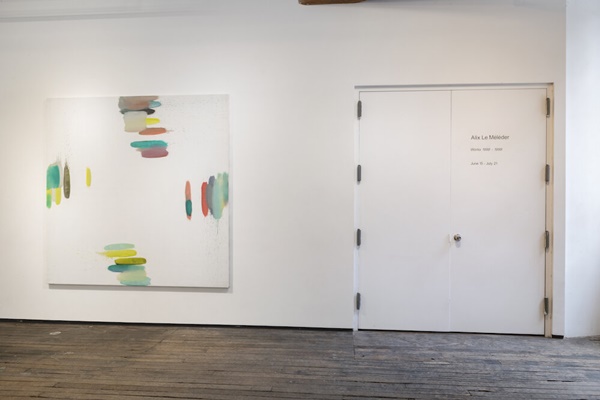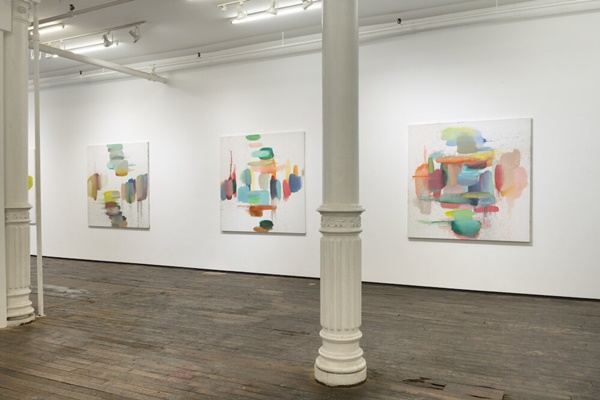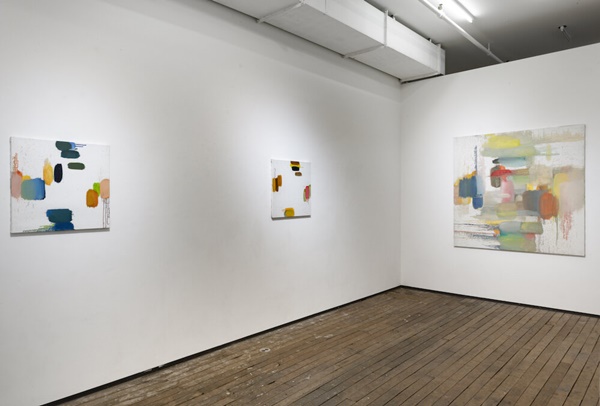"Works 1997 - 1999"
Alix Le Méléder

Zürcher Gallery
33 Bleecker Street New York NY 10012Phone : +1 212 777 0790 Fax : +1 212 777 0784 e-mail:
Multiple location : New York Paris



June 15 > July 21, 2021



Zürcher Gallery is thrilled to present the first solo-exhibition in New York of Alix Le Méléder (born 1956 in Boulogne sur Seine (France). Alix graduated from the Ecole des Beaux-Arts of Paris (from the Sculpture department where she studied with the sculptor Cesar Baldaccini). After graduating, she resumed painting in 1985 and moved to La Villette into a warehouse which burned down in 1990. She lost all her work. When she emerged from this big trauma, her work developed in an impressive way. The City of Paris then gave her a large studio she occupied until she stopped painting in 2011. In the early 90’s she met Shirley Jaffe who introduced her to Jean Fournier gallery, the gallery of Joan Mitchell, Sam Francis and Kimber Smith in Paris. Alix showed there until 2004 before joining Galerie Zürcher Paris/New York who now represents her work.
Alix Le Méléder has never claimed to belong to any abstraction movement or to descend from one group, not even Supports/Surfaces. She occasionally found herself in contact with some members of Supports/Surfaces when she was showing at Jean Fournier Gallery but she never felt the need to belong to any group. She’s always been fiercely independent and extremely singular in her thinking and practice.
In this first presentation of Alix’s work in New York, I chose to show her works from the late 90’s, more precisely 1998-1999 which depart from her early neo-expressionist gestural paintings reminiscent of Willem de Kooning or Per Kirkeby.
I quote Alix: “I looked to free myself from any forms of expression and wanted painting to start again from color, to reveal things.” In 1994 Alix decided to work exclusively on square formats. “I never relied on the visual but on perception. I felt the need to blow out the space even more. This is the reason why I decided to use the square format. In order to avoid an horizontal confrontation with the painting, I chose to rotate it.”
Alix does not paint on the ground but vertically. In 1995, the white background started peeking through the saturated palette. Paint became thinner, lighter and warmer but the oblique brush strokes still indicated some form of expressionism. In 1997 they give away to a more rigorous organization, the direction of the drips indicating a rotation of the canvas. In 1998, the center of the painting was left empty and in 1999 she started gradually to apply only two or three brush marks on each of the 4 sides of the painting. The brush marks became less gestural, of different colors, migrated to the sides of the painting, as if its endless rotations were pushing them out in a centrifugal way. The painted shapes determine directions and suggest movements. The space is stabilized yet in perpetual motion. Alix does not mix her primary colors but the colors she uses are mixing when applied onto the canvas. She paints from top to bottom and from left to right. From one canvas to another, differences appear, they are pronounced enough so that each work can be differentiated. They have an intrinsic “anthropological” quality.
Alix follows her own painting protocol which she described to Patrick Autreaux as “a trance-like ritual for each painting session: a card game of solitaire played until she could intuit the cards, followed by the clockwise spinning the canvas after each stroke, the brush dipped in a different primary color each time, each painting usually completed in one sitting.”
I quote Philippe Dagen: “Alix Le Méléder’s paintings touch us so deeply and lastingly, might it not then be because, forcing themselves out of current stylistic and aesthetic habits, they remind us, with a force that never weakens, that the power of art ... is to show the implacable singularity of a human being who refuses to give in and disappear when everything seems to condemn us to this effacement?”
Excerpt from « Paint so as not to disappear » by Philippe Dagen published in 2006 by Galerie Zürcher, Paris
Gwenolee Zürcher
June 2021, New York
Alix Le Méléder was born in 1955 in Boulogne sur Seine, France. She lives in Burgundy and Brittany, France. She studied sculpture at Beaux-Arts, Paris and L’Atelier César from 1974 to 1979. In 1990, the building where she had her studio burned down. She lost all her works. In 1992, Alix met Shirley Jaffe who introduced her to Galerie Jean Fournier in Paris.
Alix Le Méléder was exhibited in numerous exhibitions at Galerie Jean Fournier in 1995, 1997, and 2001-2002. In 2004, she joined Galerie Zürcher and was exhibited regularly in 2005, 2006, 2008, and 2010 with solo exhibitions and several group exhibitions in Paris and New York. In 2020, the Chateau de Tours (Tours, France) presented a retrospective of her paintings from 1987 - 2011, taking up an entire floor of their exhibition spaces. She was also recently included in a group exhibition at Zürcher Gallery NY with Tom Doyle, Kazuko Miyamoto and Lynn Umlauf.
Alix Le Méléder has never claimed to belong to any abstraction movement or to descend from one group, not even Supports/Surfaces. She occasionally found herself in contact with some members of Supports/Surfaces when she was showing at Jean Fournier Gallery but she never felt the need to belong to any group. She’s always been fiercely independent and extremely singular in her thinking and practice.
In this first presentation of Alix’s work in New York, I chose to show her works from the late 90’s, more precisely 1998-1999 which depart from her early neo-expressionist gestural paintings reminiscent of Willem de Kooning or Per Kirkeby.
I quote Alix: “I looked to free myself from any forms of expression and wanted painting to start again from color, to reveal things.” In 1994 Alix decided to work exclusively on square formats. “I never relied on the visual but on perception. I felt the need to blow out the space even more. This is the reason why I decided to use the square format. In order to avoid an horizontal confrontation with the painting, I chose to rotate it.”
Alix does not paint on the ground but vertically. In 1995, the white background started peeking through the saturated palette. Paint became thinner, lighter and warmer but the oblique brush strokes still indicated some form of expressionism. In 1997 they give away to a more rigorous organization, the direction of the drips indicating a rotation of the canvas. In 1998, the center of the painting was left empty and in 1999 she started gradually to apply only two or three brush marks on each of the 4 sides of the painting. The brush marks became less gestural, of different colors, migrated to the sides of the painting, as if its endless rotations were pushing them out in a centrifugal way. The painted shapes determine directions and suggest movements. The space is stabilized yet in perpetual motion. Alix does not mix her primary colors but the colors she uses are mixing when applied onto the canvas. She paints from top to bottom and from left to right. From one canvas to another, differences appear, they are pronounced enough so that each work can be differentiated. They have an intrinsic “anthropological” quality.
Alix follows her own painting protocol which she described to Patrick Autreaux as “a trance-like ritual for each painting session: a card game of solitaire played until she could intuit the cards, followed by the clockwise spinning the canvas after each stroke, the brush dipped in a different primary color each time, each painting usually completed in one sitting.”
I quote Philippe Dagen: “Alix Le Méléder’s paintings touch us so deeply and lastingly, might it not then be because, forcing themselves out of current stylistic and aesthetic habits, they remind us, with a force that never weakens, that the power of art ... is to show the implacable singularity of a human being who refuses to give in and disappear when everything seems to condemn us to this effacement?”
Excerpt from « Paint so as not to disappear » by Philippe Dagen published in 2006 by Galerie Zürcher, Paris
Gwenolee Zürcher
June 2021, New York
Alix Le Méléder was born in 1955 in Boulogne sur Seine, France. She lives in Burgundy and Brittany, France. She studied sculpture at Beaux-Arts, Paris and L’Atelier César from 1974 to 1979. In 1990, the building where she had her studio burned down. She lost all her works. In 1992, Alix met Shirley Jaffe who introduced her to Galerie Jean Fournier in Paris.
Alix Le Méléder was exhibited in numerous exhibitions at Galerie Jean Fournier in 1995, 1997, and 2001-2002. In 2004, she joined Galerie Zürcher and was exhibited regularly in 2005, 2006, 2008, and 2010 with solo exhibitions and several group exhibitions in Paris and New York. In 2020, the Chateau de Tours (Tours, France) presented a retrospective of her paintings from 1987 - 2011, taking up an entire floor of their exhibition spaces. She was also recently included in a group exhibition at Zürcher Gallery NY with Tom Doyle, Kazuko Miyamoto and Lynn Umlauf.
 | Alix Le Méléder | |
Opening Reception:
June 15, 4 - 6 PM
Capacity will be limited to 20 visitors at the opening at a time.
Please maintain social distance,
wear a mask,
and limit your visit to 15 minutes if there are others waiting.
Capacity will be limited to 20 visitors at the opening at a time.
Please maintain social distance,
wear a mask,
and limit your visit to 15 minutes if there are others waiting.
mpefm
USA art press release
Opening hours :
Tues-Sat / 12pm - 6pm / Sunday 2-6pm

QR of this press release
in your phone, tablet








